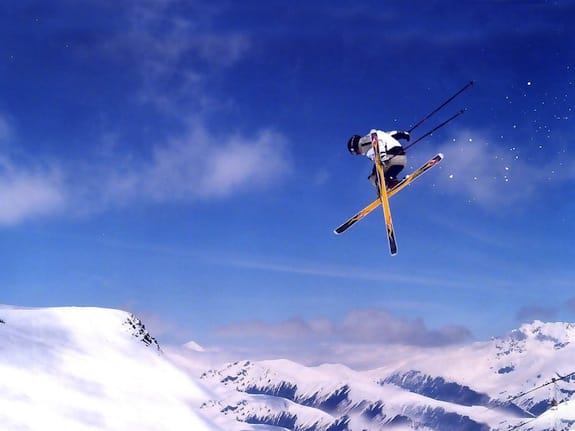Ready to carve some turkeys on the slopes? One of the best ways to get a good deal on downhill skis and snowboards is to buy them used. How many people do you know that bought fancy skis and bindings and almost never use them? These awesome skis often end up at a sweet price on Craigslist or eBay.
We’ve put together a price guide for downhill skis. We have some of the most popular ski manufacturers’ products catalogued here. You can also search for any model of skis, bindings, boots, or snowboards in our search box. May you have many powder days! To kick off our price guide, Priceonomics contributor Valerie Farabee has put together a basic guide to downhill skis.

Image Credit: WCHS.
How I Learned to Stop Worrying and Love the Slopes
The warm, smoky smell of winter is in the air, and with it the thrill of the impending ski season. For those of us lucky enough to get to the winter mix this season, here are a few tips on choosing downhill skis for when you hit the slopes!
Size Matters
When choosing downhill skis you must consider your body type, skiing style, and the type of snow you most often ski in order to choose the best downhill ski for you. The size of your ski will depend on your height, weight, and proficiency.
The width of the ski is measured in millimeters, and is given at three different points of the ski: the width of the tip x the width of the binding under the foot x width of the back of the ski. The wider the ski the more float you will get on deep powder, but you will have less stability on hard pack snow.
The length of the ski is given in centimeters. Standard adult sizes range between 140-190 cm in length. Long skis are more stable at higher speeds and provide more lift, while shorter skis turn more quickly. The beginner, who will usually avoid high speeds right off the bad, will prefer a shorter ski while still learning.
Materialism, Inc.
The majority of skis are made up of wood, foam, or a composite of both. Wood skis add weight but provide durability and stability. Foam core skis are super light and great for kids. For the best of both worlds, choose a composite ski that has both the light weight of a foam core and the durability of a wood core. Many of these composite skis can be found at a discount price if you raid sales of last years models.
Extra, Extra!
Now that you’ve decided on a size and type of ski it’s time to add some necessary bells and whistles.
Bindings and boots: Bindings and boots are important because they are the link between your body and the ski. The type of binding you get will depend on your proficiency, and it is very important to be honest about your skill level when choosing a binding. Choose a binding that fits your current level but leaves room to grow.
Goggles, gloves, and protection: It is important to protect your eyes and body from the sun, wind, and snow while you are skiing! Sunglasses look cool, but goggles provide the most protection from the wind and elements.
Poles: Ski poles help improve stability, and are used for propulsion by skiers on flat surfaces or slight uphill inclines.
It goes without saying, but don’t forget a jacket, hat, and lift tickets too!
The Price is Right
Kids skis can be found for between $75-$250 at most stores, and adult skis range between $300-$1200. The price varies so greatly with adult skis due to the quality of the material, as we talked about earlier, and also due to the manufacturer. Foam skis will be the least expensive and the best for beginners. Boots and bindings ad significantly to the cost as well; this is not an inexpensive sport!
Be safe, learn the rules of the mountain, and most of all, have fun!



